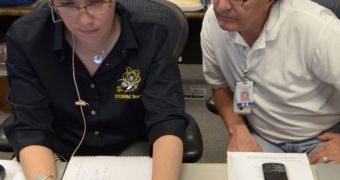Astronauts aboard the space shuttle Endeavour completed the first-ever test of the new navigation system that will go on the Orion Multi-Purpose Crew Vehicle (MPCV) yesterday. During the maneuvers, the spacecraft approached the ISS behaving like the new space capsule.
The latter is currently being built by main contractor Lockheed Martin, which is also the developer of the tested system. Called the Sensor Test for Orion Relative Navigation Risk Mitigation (STORRM), its job is to use lasers to guide the MPCV to its docking port, and assist with these procedures.
NASA identified this system as absolutely critical for the next generation of spacecraft that will fly to the ISS. As such, demonstrating its capabilities became vitally important for Lockheed.
The stake was raised further a few days ago, when the American space agency announced that it had selected the MPCV for further development. The main objective of this effort is to produce a capsule capable of carrying astronauts to near-Earth objects by 2025 and Mars by the mid-2030s.
These are the directions in which the Obama Administration wants NASA to head, and the agency is complying. Until work could progress further, the STORRM sensor had to be put through its paces.
As Endeavour's STS-134 Commander Mark Kelly was coordinating the maneuver, the shuttle separated from the International Space Station on May 29, and then sought to approach the facility again.
This occurred at 3:24 am CDT (0824 GMT) on Monday, a press release from Lockheed informs. It also adds that this was the first and only time when the three main space programs NASA runs – the Space Shuttle Program, the ISS, and the Orion MPCV – got a chance to collaborate.
With help from ground teams at NASA, Lockheed and Ball Aerospace & Technologies Corporation, STS-134 mission specialist Andrew Feustel supervised the behavior of the STORRM sensor during Endeavour's approach to the station.
“This flight test demonstrated the exceptional capability of the Vision Navigation Sensor (VNS) and the Docking Camera, two key components of the Orion relative navigation system,” explains Lockheed electro-optics engineer Catherine Boone, PhD.
“We were able to collect about 600 gigabytes of data that will verify the design meets the high performance standards required for Orion MPCV and other future spacecraft,” she goes on to say.
“Follow-on testing at our Space Operations Simulation Center […] will also provide an opportunity to look at how we may be able to expand on that performance to make the system as powerful and accurate as possible for the dynamic environments of deep-space exploration missions,” Boone adds.
She helped Feustel carry out his tasks from the NASA Mission Control Center during yesterday's tests.
“The Lockheed Martin, Ball and NASA STORRM team worked efficiently and seamlessly to accomplish this important risk mitigation test,” Lockheed MPCV deputy program manager Larry Price says.
“It was an immense undertaking and everyone gave it their all to design a system necessary for future exploration spacecraft to conduct safe approach and docking maneuvers to other spacecraft,” he concludes.

 14 DAY TRIAL //
14 DAY TRIAL //